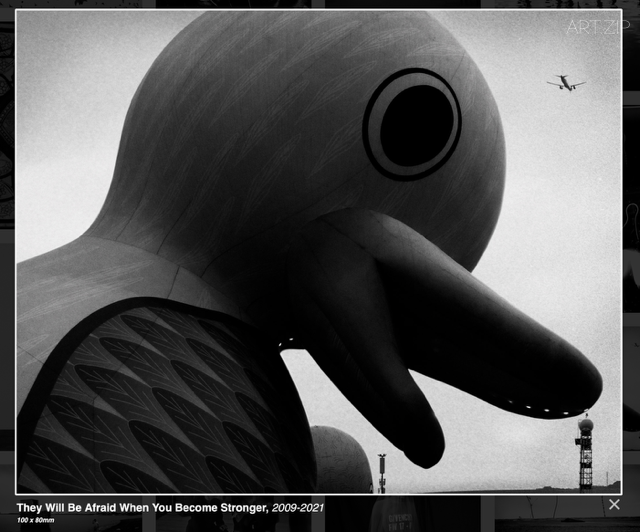
The renowned art historian E.H. Gombrich once noted in the second half of the twentieth century, 「Ours is a visual age. We are bombarded with pictures from morning till night.」 This signifies a continuous enhancement in the efficiency of information transmission, with traditional methods of information replication and dissemination, predominantly led by written language, facing unprecedented transformation. As the cost of image production continues to decrease, the ability to recreate reality has become increasingly labour-time cost, fundamentally reshaping our sensory world.
Xu Xiaowei’s exhibition Spacing Memories comprehensively presents the profound shift in early twenty-first-century human visual culture towards a blend of virtuality and reality. Furthermore, the artist keenly captures the uniqueness of visual language, focusing his photographic work more intently on the texture, quality, and presence of digital imagery.
Meticulously curated by the OFOTO Gallery, this exhibition distinguishes itself from the gallery’s traditional style photography shows through its high-standard coordination in various dimensions such as image, light and shadow, tone, and material. The visual immediacy, within a softly focused atmosphere, appears restrained and profound, yet retains a sense of energy.
著名藝術史學家貢布里希曾在上世紀中後期指出,「我們正日益步入一個圖像的世界」。這意味著信息傳遞的效能不斷提升,以語言文字為主導的傳統信息複製與傳播方式正面臨前所未有的變革。隨著圖像製作成本持續降低,還原真實變得愈發容易,我們的感官世界也由此被徹底重塑。
徐曉偉的展覽《記憶空間》全面呈現了21世紀初人類視覺文化逐漸走向虛實交織的深刻轉變。不僅如此,藝術家敏銳地捕捉到影像語言的獨特性,使其攝影作品更加聚焦於數字影像的質感、品質與存在感。
在全攝影OFOTO畫廊的精心策劃下,本次展覽通過高水準的展陳協調,在圖像、光影、色調與材質等多個維度,與以往「文藝小資式」的攝影展劃清界限。視覺的臨場感在柔和聚焦的氛圍中顯得內斂而深沉,同時不失力量感。
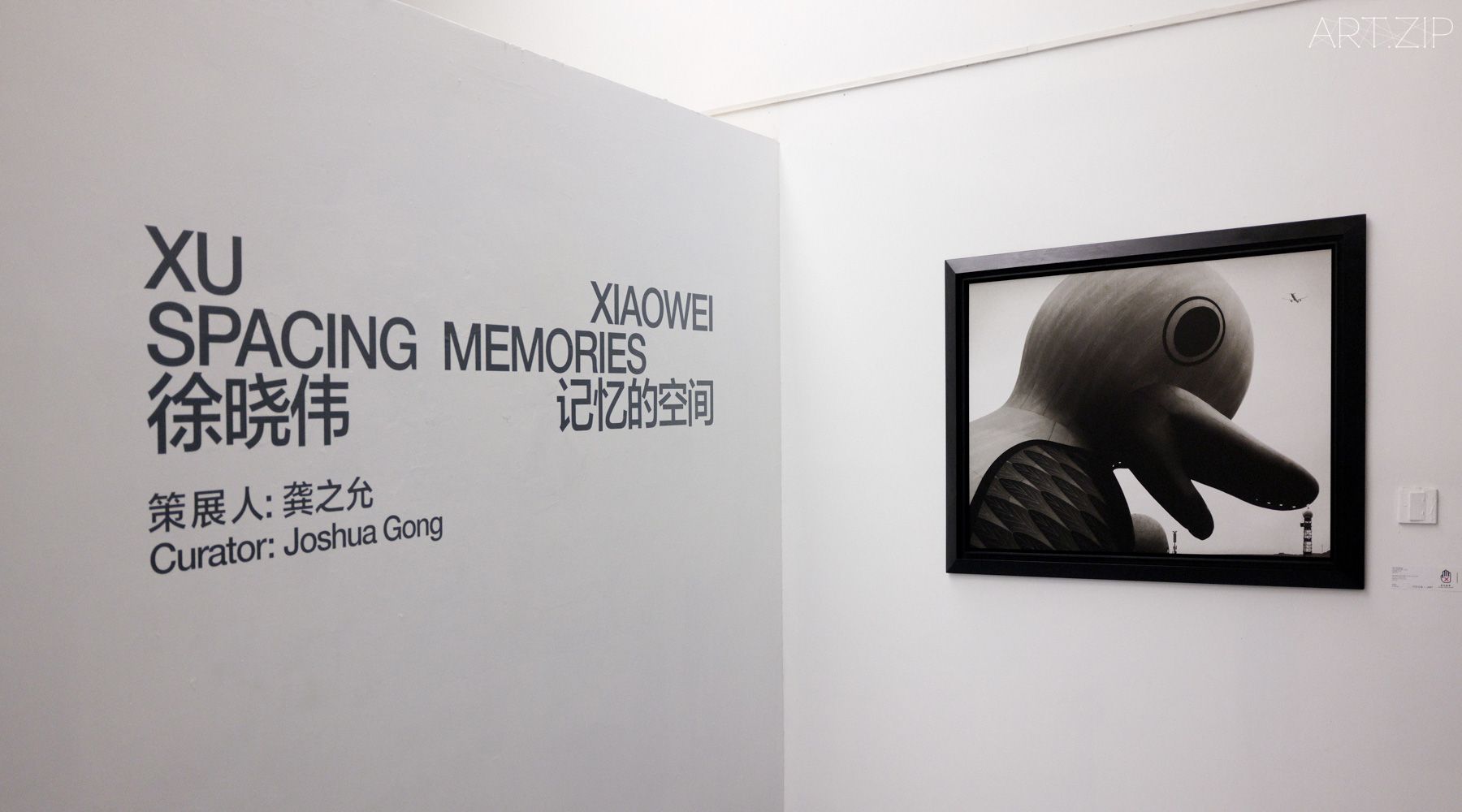
Installation shot of the exhibition. Courtesy of the artist.
The exhibition space unfolds at a measured pace. At the entrance, beside the title, is the work They Will Be Afraid When You Become Stronger, featuring an inflatable duck larger than a tower, presenting an alienation of the real landscape and a sense of authority. The physical characteristics of the inflatable duck, interpreted through Xu Xiaowei’s lens, are endowed with a parable-like humanistic quality. The seemingly montage-style image collage gives the black-and-white gradations of the picture a sensory texture reminiscent of memory granules.
Subsequent black-and-white photographic works are arranged rhythmically at a position slightly above the human eye level. Black frames complement the white walls and gray floor, creating an atmosphere that resonates with the creative theme. Individual memory and collective perception undergo a fascinating chemical reaction within this pure space. Many visitors linger for a long time, moving from initial surprise upon first glance, to astonishment upon closer reading, and finally to a knowing smile when appreciating the whole—fully reflecting the high standard of the exhibition design. Art originating from life, with the flickering fragments of memory behind the images, allows the audience to find a familiar warmth within the differences; while the visual language that transcends life endows known visual experiences with new dimensions of interpretation and reflection.
The exhibition aims to evoke viewers’ sensitive nerves through the works, guiding people to return to their origins, look back on the path travelled, and contemplate future possibilities. This is precisely the viewing experience that “Spacing Memories” hopes to convey.
展覽空間節奏舒緩有致,入口處標題旁陳列的作品《變強了他們就會怕》,以一隻比高塔更為龐大的充氣鴨子,呈現出現實景觀的異化與威權感。充氣鴨子的物理特性,在徐曉偉的鏡頭詮釋下,被賦予了一層寓言般的人文色彩。看似蒙太奇式的圖像拼貼,使畫面的黑白層次呈現出記憶顆粒般的感官質地。
隨後的黑白攝影作品以略高於人眼視線的位置依節奏排列。黑色畫框與白牆灰地相互映襯,營造出與創作主題共鳴的氛圍。個體記憶與集體認知在這一純粹空間中發生出奇妙的化學反應。許多觀眾駐足良久,從初見的驚喜,到細讀之後的訝異,再到整體品味時的會心一笑,充分體現出展覽陳設的高水準。源於生活的藝術,因圖像背後閃爍的記憶片段,讓觀眾在差異中尋得熟悉的溫度;而高於生活的視覺語言,則賦予已知視覺經驗新的解讀與思考維度。
展覽意圖通過作品觸動觀者敏銳的神經,引導人們回歸自我原點,回望來路,並展望未來的可能性。這正是《記憶空間》希望傳遞的觀展體驗。
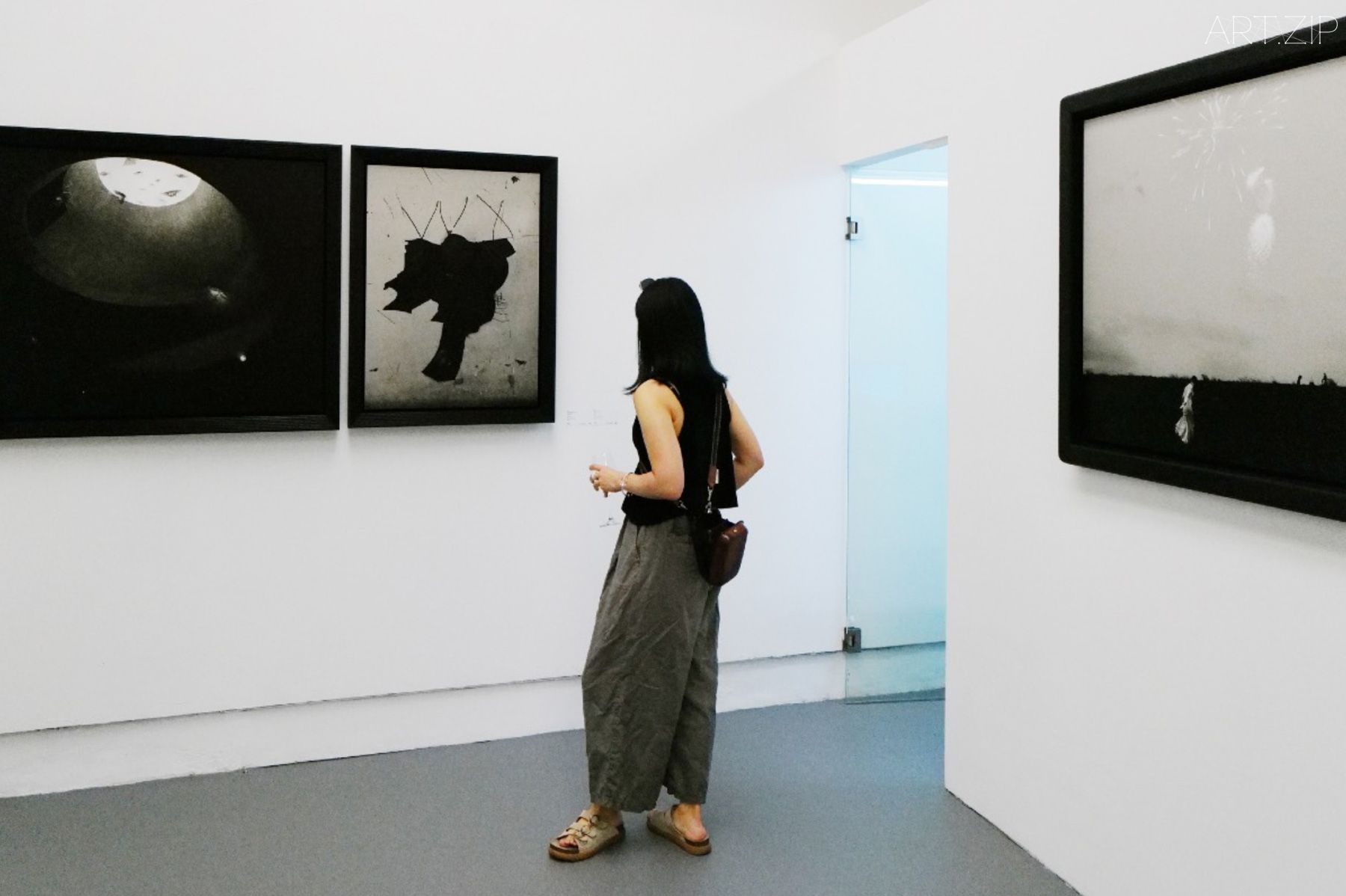
Installation shot of the exhibition. Courtesy of the artist.
With the rapid development of digital replication and artificial intelligence technology, creating deceptively realistic images has long been technically feasible. The challenge facing photographers and artists now is this: when technology no longer poses a barrier to creation, can they still, through keen observation and skilled expression, construct an immersive visual field that makes one linger—a humanistic space where one can profoundly perceive the flow of energy? After all, the core of the era of traffic (influence/attention economy) is not headlines or click-through rates, but artistic forms that can truly make people pause for a long time and continuously refresh their sensory experiences.
To this end, Xu Xiaowei has broken through the limitations of traditional photography, fully integrating digital technology while consistently maintaining a high degree of control over material and texture. Through repeated adjustments, he finds the meeting point between the digital virtual and physical reality. His image sources stem from life, yet within the ordinary, he captures the marvel of existence.
隨著數碼複製與人工智能技術的迅猛發展,以假亂真的圖像還原與呈現早在技術上不再困難。擺在攝影師與藝術家面前的挑戰在於:當技術不再構成創作的壁壘,是否仍能憑借敏銳的觀察與嫻熟的表達,營造出一個令人沈浸其中、流連忘返的視覺場域——一個能讓人深刻感知能量流動的人文主義空間?畢竟,流量時代的核心並非標題或點擊率,而是真正能夠讓人長久駐足、持續刷新感官體驗的藝術形式。
為此,徐曉偉突破了傳統攝影的局限,全面融匯數字技術,同時始終保持對材質與質感的高度把控,在反復調試中尋得數碼虛擬與物理真實之間的契合點。他的影像素材源於生活,卻在平凡中捕捉到生命的奇觀。
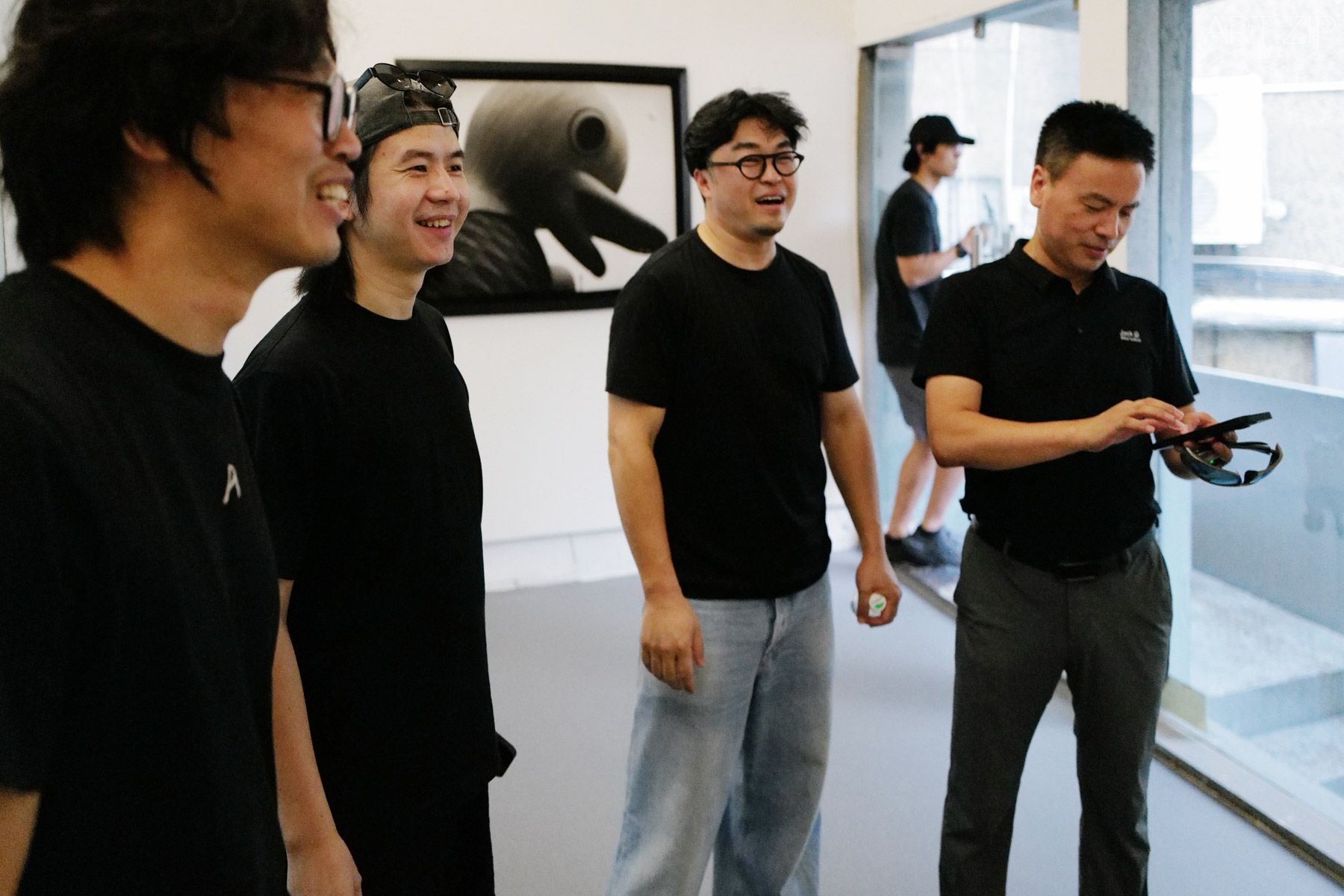
Installation shot of the exhibition. Courtesy of the artist.
As the internationally renowned master of photographic art, Roger Ballen, remarked after viewing Xu Xiaowei’s work: “Ultimately, Xiaowei’s work admirably embodies the complexities of modern Chinese culture, revealing the interplay between tradition and progress, absurdity and reality, within the framework of collective memory. Through this lens, I find not only kinship with the artist but also a mirror reflecting my own artistic journey.”
正如國際影像藝術大師羅傑·拜倫觀賞徐曉偉的作品後所感嘆的那樣:「曉偉作品中荒謬的存在,讓我能繼續探索記憶的深處。他的作品再次煥發了我對攝影藝術的思考:攝影作為一種超越時間和空間的媒介的力量,它捕捉了我們經歷和情感的短暫本質。 」
Q&A with Artist Xu Xiaowei|專訪徐曉偉
AZ:Could you share how this exhibition came about?
XXW:My representing gallery recommended me to participate in the 2025 Jimei x Arles International Photo Festival. However, I hadn’t previously been presented specifically as a visual artist. Since there was still some time before the photo festival, the gallery adjusted its schedule to hold this exhibition. From my perspective, this marks a new beginning as an artist and also makes it easier for more people to understand my art.
AZ:Your work often touches on memory and transformation—how do these ideas shape the themes and methods of your artistic practice?
XXW:The core of my creation is the reconstruction of personal memory. I grew up during the late 20th and early 21st centuries, personally experiencing the rapid development of China and the world. The environments I have lived in have undergone multiple transitions, from agrarian civilisation to industrial culture, and then to the post-industrial era. Such drastic changes have caused the surrounding images to lose their logic, while the advent of the information age has made the replication and reinterpretation of images possible. My work precisely deconstructs and reshapes at the intersection of memory and social development, breaking the linear narrative of time. Using fragments of memory and environmental changes, I guide viewers to generate new thoughts about the images within a familiar warmth.
AZ:能否談談這次展覽的契機?
XXW:代理畫廊主推我代表畫廊參加2025集美·阿爾勒國際攝影季,但這之前我並沒有以影像藝術家的身份露出,因此需要一個比較契合的活動進行對外展示和預熱。由於距離參與攝影季之前還有一段時間,因此畫廊調整了檔期進行這次展覽。從我的角度講,這是一次嶄新的開始之路,同樣也方便更多的人瞭解我的創作。
AZ:你的作品常與記憶和變遷相關——這些概念如何塑造了你創作的主題與方法?
XXW:我的創作核心是對個人記憶的重構。我成長於20世紀和21世紀之交,親歷了中國乃至全球的迅猛發展,我生活過的環境從農耕文明到工業文明,再到後工業時代的多重躍遷。這種劇烈變化使周遭圖像喪失邏輯,而信息時代的到來,又讓影像的複製與再詮釋成為可能。我的作品正是在記憶與社會發展的交匯點上進行解構與重塑,打破時間的線性敘事,用記憶片段與環境變遷,引導觀者在熟悉的溫度中,對圖像產生新的思考。
AZ:Among your works, is there one that particularly embodies your artistic vision or cultural reflections? Could you share the story behind it?”
XXW: A Shadowed Gentleman here includes both the bamboo traditionally revered by scholars and pixelated human forms, representing the diverse aspects of contemporary life. Scholars from Riversouth (Jiangnan) always maintain a pastoral sentiment. When building their private residences, they used lattice windows and the technique of “changing scenery with each step”, using the view outside the window to adorn their inner world, extending new spaces through imagination within limited physical confines. Seeing the shadow of bamboo outside a window in Shanghai can evoke infinite historical and artistic imagination for me. The window is an important symbol of Western modernism, while the bamboo grove is a unique spiritual sustenance for Chinese scholars. My work A Shadowed Gentleman aims to extract that modernist texture from contemporary Chinese society and combine it with bamboo to create a unique visual symbol belonging to our culture.
Sometimes our vision is obscured by forces beyond ourselves. When we look at things from another perspective, such as observing through shadows or reflections, it might provide visual clues to help us find our true self and our real engagement with the tangible world.
AZ:Many of your works have resonated strongly with audiences. Could you talk about which pieces have drawn the most attention, and why you think they strike such a chord?
XXW:Two works have received considerable attention: They Will Be Afraid When You Become Stronger and The Feast of the Gods.
The visual impact is very significant for the meaning of the object. When an inflatable duck reaches a certain size, it can bring an astonishing sense of pressure to an originally harmless and cute image. Here, an aeroplane contrasts with it, both directing the viewer’s gaze beyond the frame and balancing the composition. When we feel powerless in life, we can also think: even doing something unusual can, at least in terms of belief, make us stronger and larger, evoking a slight awe of ourselves.
The form of deities can give viewers different feelings in different contexts. When statues of gods are enshrined in temples, the lighting, incense, and sounds make us respectful. Those statues placed high up receive the admiration of believers. It’s hard to imagine, in a place where gods are made, when we look at a pile of deity statues from a level or even a bird’s-eye angle, the sanctity and rarity of the ideal projection are dissolved by mundanity. The Feast of the Gods has a strong expression of absurdity. The appearance of the panda image, which seems neither purely good nor evil, also highlights the theme of the work. When we observe pandas in zoos, they are assigned a cute image; it seems their wildness has been removed or placed within our controllable range. Pandas actually once possessed immense vitality and fighting strength. It is our human cultural construction that has labelled both pandas and deity statues.
The Feast of the Gods breaks that specific cultural construction, allowing us to reflect on some seemingly normal yet unreasonable phenomena in life.
AZ:Exhibition-making often involves negotiation between artistic vision and curatorial strategy. How did this dialogue unfold in your case, and what role did the curatorial team play in shaping the final presentation?
XXW:We have a very professional curatorial team. Everything was set in the early stages and didn’t require much adjustment. As the artist, I actually intended to leave the task of interpreting the works to the curator. During this period, curator Joshua Gong formed a detailed understanding of the venue environment and also selected works according to different themes. Under the meticulous planning of OFOTO Gallery, the floor colour was changed, and simulations were created. By adjusting the lighting, the works appear restrained and profound within a soft, focused atmosphere, without losing their sense of power.
AZ:This exhibition also serves as a prelude to your upcoming presentation at the Jimei x Arles International Photo Festival. In what ways do you envision the dialogue or continuity between the two exhibitions?
XXW:There might be minor adjustments to a small number of works based on different exhibition environments, but the overall structure will not change. For the Jimei x Arles exhibition space, we will stage a darker environment to enhance the viewer’s immersive experience. Sound effects that harmonise with the works will also be added, and spotlights will be used to highlight the works, creating a stronger impact.
AZ:在你的作品中,是否有一件特別體現你藝術觀念或文化思考的作品?能否談談它背後的故事?
XXW:我這裡拍攝的影子,既包含了傳統文人所推崇的竹子,又用馬賽克式的人形,展示了當代生活中的形形色色。江南的讀書人總保持著一分田園情懷,在打造私家宅院的時候,會採用花窗,移步換景。用窗外的景色點綴自己的內心,在局促的物理空間中,憑借想象力,延伸出新的空間。我在上海看到窗外竹子的影子,就能激發出無限的歷史和藝術的想象。窗是西方現代主義的重要象徵物,竹林是中國文人所特有的精神寄託物。我的《影君子》希望把那種現代主義的質感從中國當代社會中提煉出來,結合竹子,營造一種屬於我們文化的特有視覺符號。
有時候我們的視野被某種非自我的力量所遮蔽,當我們從另一個角度來看事物,比如從影子或者鏡像中觀測,也許能為我們找到本心和真相提供一種視覺線索。
AZ:你的許多作品引起了觀眾強烈的共鳴。能否談談哪幾件作品最受關注,以及你認為它們為何能觸動人心?
XXW:有兩張被關注的比較多:《變強了他們就會怕》和《眾神之宴》。《變強了他們就會怕》 視覺的衝擊力,對於物象有著非常重要的意義。當一個充氣鴨子達到一定程度之後,能讓本來人畜無害的可愛形象帶來驚人的壓迫感。在這裡一架飛機與之對比,既能把觀眾的視野引向畫外,又起到平衡畫面的作用。當我們在生活中感覺無力的時候,也可以思考,其實我們做點不常做的事情至少在信念上可以變強變大,讓自己稍稍敬畏。
《眾神之宴》神的造型在不同的場域會給觀者不同的感受。當神像被供奉在廟宇中的時候,光線、香氣和聲音,都會讓我們肅然起敬。那些個被放置於高處的神像,會得到信徒們的瞻仰。很難想象,在造神的場地,當我們用平視甚至是俯視的角度來看待一堆神像時。那種理想投射的神聖性和稀有性,被世俗性所瓦解。眾神之宴有著很強的荒誕表達。亦正亦邪的熊貓形象的出現,也點亮了作品的主題。當我們在動物園中審視熊貓的時候,熊貓被賦予了可愛的形象,似乎熊貓的野性被去除了,或者被置於我們可控的範圍內。熊貓實際上曾經擁有非常頑強的生命力和戰鬥力。是我們人類的文化構建,把熊貓和神像進行了標籤化。
《眾神之宴》打破了那種特定的文化構建,讓我們可以反思生活中一些看似正常卻又不合理的現象。
AZ:展覽的呈現往往涉及藝術家與策展策略之間的對話。在你的展覽中,這樣的交流是如何展開的?策展團隊在最終呈現中起到了什麼作用?
XXW:我們有一個很成熟的團隊,這些都是前期都設定好的並不需要進行過多的調整。作為創作者,我其實是想把解讀的思路交給策展人來梳理,策展人龔之允先生這期間對場地環境進行了詳細的瞭解,同時對作品也根據不同的主題進行了篩選。在全攝影OFOTO畫廊的精心策劃下,更改了地面的顏色,並建立了模擬圖,通過調整燈光讓作品在柔和聚焦的氛圍中顯得內斂而深沈,同時不失力量感。
AZ:這次展覽同時也是你即將參與的集美·阿爾勒國際攝影節的前奏。你如何看待這兩場展覽之間的呼應或延續性?
XXW:不同的布展環境可能會有小部分作品的調整,但是大的結構不會進行調整。在集美·阿爾勒的展廳,我們做的是黑場的環境,也會有跟作品契合的音效的加入,同時用切光燈突出作品,創造更強的衝擊力。
AZ:How would you describe the ways your work diverges from traditional photography, both formally and conceptually?
XXW:There are some differences from traditional photography in terms of content, form of expression, and humanistic reflection. My artworks integrate painting and photography; the reality, visuality, and emotionality they present all reveal humanity’s yearning for existence and its uncertainty.
In terms of presentation form, we still follow the most common methods. In terms of content, the image narratives all originate from the rapidly developing contemporary society. In terms of form, we are pursuing a special texture in the imagery, emphasising the potential of light and shadow language to deconstruct time and space. Regarding humanistic thinking, by perceiving the energy field within change, a kind of eternity is composed of multiple moments and presented on a single, unified image.
AZ:Looking ahead, how do you envision the direction of your artistic journey? Are there particular themes or forms you wish to expand upon in your upcoming projects?
XXW:The creative plans have never stopped. There will be a large number of colour works released later, and I will extend and deepen the existing series.
AZ:你會如何描述自己的作品在形式與理念上與傳統攝影的差異?
XXW:從內容、表現形式、以及人文思考上跟傳統的攝影有一些區別,綜合了繪畫與攝影,其所呈現的現實性、視覺性和情感性都顯示了人對於存在的渴求與不確定性。
呈現形式上還是在遵循最普遍的方式。內容上看,圖像敘述都源於發展迅猛的當代社會。 從形式上 ,在追尋一種特殊的影像質感,強調光影語言解構重組時空的可能性。對於人文主義的思考,通過感悟變化中的能量場,把一種永恆性,用多個瞬間構成,呈現在了一個整體圖像上。
AZ:展望未來,你如何構想自己的藝術道路?在接下來的計畫中,是否有想要拓展的主題或形式?
XXW:創作計劃從來沒有停下過,之後會有大量彩色的作品推出,並對現有的系列進行延伸和深化。
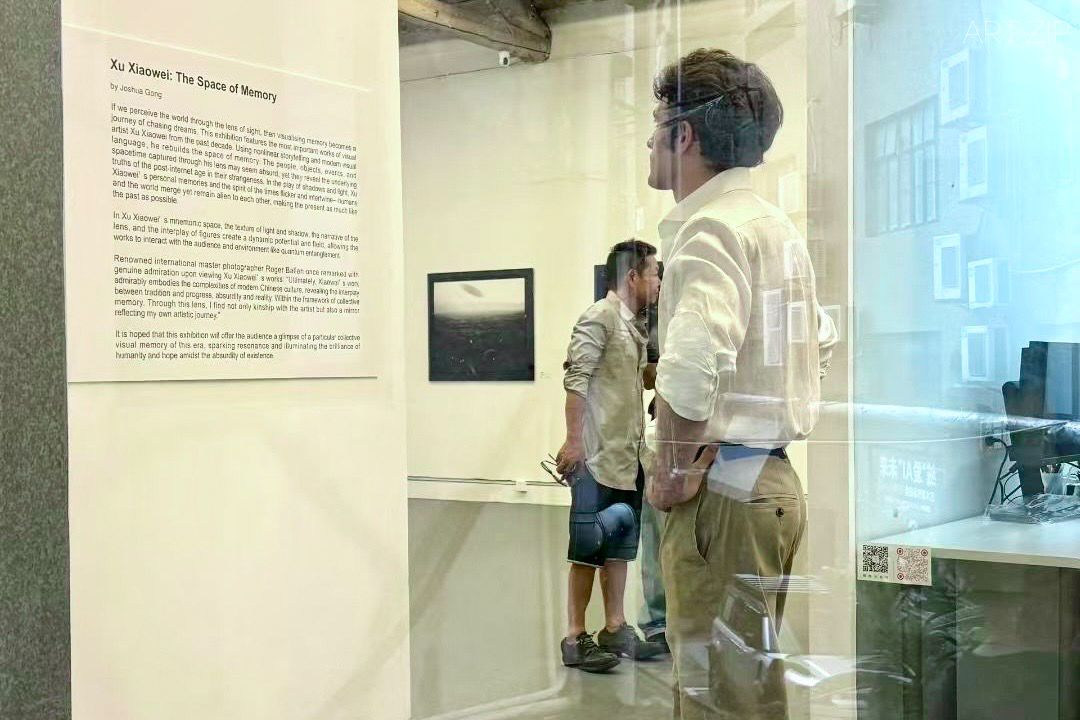
Installation shot of the exhibition. Courtesy of the artist.
About the artist 關於藝術家
Xu Xiaowei is a celebrated Chinese photographer whose surreal, layered compositions capture the dissonant beauty of contemporary existence. Merging documentary precision with dreamlike collage, his work explores the tension between tradition and modernity, memory and reality, in a rapidly evolving society. A master of visual storytelling, Xu transforms the ordinary into the extraordinary, revealing the uncanny poetry hidden within everyday life.
Internationally acclaimed, Xu has been honoured with prestigious awards, including Gold in Press/Fashion at the Prix de la Photographie Paris and the Communication Arts Award of Excellence(2017).
His debut series, Spacing Memories, garnered critical praise from leading publications like Amateur Photographer (UK), Fisheye Magazine (France), and Visionaire (China). Legendary photographer Roger Ballen hailed his work as ” Ultimately, Xiaowei’s work admirably embodies the complexities of modern Chinese culture, revealing the interplay between tradition and progress, absurdity and reality, within the framework of collective memory.”
Represented by OFOTO Gallery and preparing for a solo exhibition at the 2025 Jimei x Arles International Photo Festival, Xu Xiaowei continues to push boundaries, using the camera not just to document, but to question, disrupt, and re-enchant the world. His images are more than photographs—they are portals into the fragile, fleeting sparks that define our shared humanity.
徐曉偉是中國備受矚目的攝影師,其超現實且層次豐富的作品捕捉了當代生存狀態中的不和諧之美。他的創作融合了紀實般的精准與夢幻般的拼貼,探索了急速變遷的社會中傳統與現代、記憶與現實之間的張力。作為視覺敘事的大師,徐曉偉將平凡轉化為非凡,揭示出日常生活中隱匿的奇異詩意。
徐曉偉享有國際聲譽,曾榮獲多項權威大獎,包括巴黎攝影獎(Prix de la Photographie Paris)新聞/時尚類金獎 以及傳播藝術卓越獎(2017年) 。他的首輯系列作品 《記憶空間》(Spacing Memories) 獲得了如《Amateur Photographer》(英國)、《Fisheye Magazine》(法國)及《Visionaire》(中國)等權威刊物的高度評價。
徐曉偉目前正為 2025年集美·阿爾勒國際攝影季的個展做準備。他持續突破邊界,不僅用相機記錄世界,更用以提問、打破並重新賦予世界魅力。他的影像不僅是照片——更是通往定義我們共同人性的那些脆弱而瞬息即逝的火花的入口。
Click to read more about Spacing Memories
About the curator 關於策展人
Joshua Gong is an art historian and curator specialising in world art, dedicated to the belief that cultural communication is the key to artistic innovation. He taught at the University of Sussex (2010–2018) before taking up a lectureship at Shanghai Normal University.
His scholarly impact is evidenced by significant accolades, including a Tate Modern Young Scholar Grant (2015). His first monograph, Iconography and Schemata: A Communicating History in Painting between China and the West, 1514–1885, was nominated for Best Art Publication by the Award of Art China in 2014. His English-language monograph, Chinese Art Today: From 20th-Century Tradition to Contemporary Practice, is regarded as an iconic work in the field. In 2021, he served as editor for the English edition of the CIHA Journal of Art History, Vol. 1 (ComitéInternational d’Histoire de l’Art, Paris).
He has also curated and sponsored major exhibitions, such as Silk Roads (The British Museum, 2024), Faith in Vision (Central Academy of Fine Arts, China, 2024), and the Art Exhibition for the 70th Anniversary of China-Pakistan Diplomatic Relations (Shanghai Centre, 2021).
He has presented artworks and exhibitions at diplomatic events for prominent international figures, including: President Alexander Stubb of Finland, Uli Sigg (former Swiss Ambassador to China and lead donor of M+ Museum), Steve Moran (US Consulate General Shanghai Facility Manager), and Hussain Haider (Consul General of Pakistan in Shanghai).
In 2025, he continued to advance his mission of cultural dialogue as an academic advisor for the CCTV4 International Channel program Meeting Civilisations.
龔之允是一位專注於世界藝術史研究的學者與策展人,致力於倡導文化溝通是藝術創新的關鍵。他曾在英國薩塞克斯大學和上海師範大學藝術史部門任教。其學術影響力獲得多項重要榮譽印證,其中包括泰特美術館青年學者獎(2015)。他的首部專著《圖像與圖式:中西繪畫的交流史(1514–1885)》曾獲”藝術中國”最佳藝術出版物提名(2014);英文專著《中國當代藝術:從二十世紀傳統到當代實踐》被學界視為該領域的標誌性著作。2021年,他擔任《國際藝術史委員會學刊》(法國巴黎)第一卷英文版校譯編輯。
在策展與實踐層面,他策劃並推動了多項重要展覽,如《絲綢之路》(大英博物館,2024)、《視覺中的信仰》(中央美術學院,2024)及《中巴建交70週年藝術展》(上海中心,2021)等。
他曾為多位國際政要與文化人士的外交活動策劃並呈現藝術作品與展覽,包括:芬蘭總統亞歷山大·斯圖布;烏利·希格(瑞士前駐華大使、M+博物館主要捐贈人);史蒂夫·莫蘭(美國駐上海總領事館設施經理);侯賽因·海德爾(巴基斯坦駐上海總領事)。
2025年,他擔任中國中央電視台中文國際頻道(CCTV4)《遇鑒文明》節目學術顧問,持續推動文明對話的使命。
Edited by x Michelle Yu










